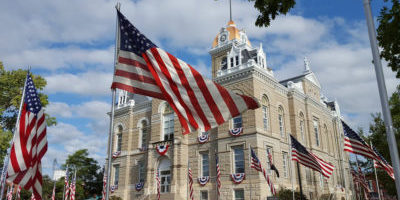The Fairbury Commercial Historic District encompasses an area spanning approximately ten blocks and 117 properties, contains ninety-seven (97) contributing and twenty (20) noncontributing properties. Virtually every street within the boundaries of the historic district are paved with brick, which were constructed circa 1916. The district is distinguished by the prominent courthouse square, where the architecturally and historically significant Jefferson County Courthouse sits, between Fourth, Fifth, D, and E streets. The oldest buildings in the district are located around the courthouse square.
The commercial center of Fairbury revolves around the Jefferson County Courthouse, which is located in the center of the downtown on the public square. The oldest buildings in the district surround the courthouse, while the later buildings fan away from the square. A majority of the commercial buildings in downtown Fairbury, which exhibit high physical integrity, are still occupied by businesses. As a result, a bustle of activity continues to occur around the courthouse square.
Many of the commercial buildings in the Fairbury Commercial Historic District are extremely intact. They retain their original form and ornamentation, particularly in the upper stories. Often, the storefronts and interiors have been altered to accommodate changing businesses. The general appearance of the district displays high integrity and very densely placed historic properties. The modern in-fill in the district totals no more than two buildings per face block.
The Fairbury Commercial Historic District represents a span of architectural periods ranging from the oldest extant, late nineteenth century building displaying false-front construction through turn-of-the-century high styles, to more modem influenced properties. The buildings in the district represent architectural development trends typical of Nebraska commercial centers. Fine representatives of Italianate, Romanesque Revival, Queen Anne, Late Gothic Revival, Neo-Classical Revival, Spanish Colonial Revival, and twentieth century commercial vernacular architectural styles and forms are located within the district. With the exception of the fringe blocks, the buildings within the district are densely packed, and consist mostly of two-story brick commercial buildings interspersed with several one-story buildings and one, three-story example. The largest amount of construction in the district during the period of significance (1873 to 1947) took place between 1900 and 1929. Built in 1891 at the cost of $60,000, the Jefferson County Courthouse is constructed of limestone. Arthur and Ferdinand Bower, stonecutters who settled here from England, cut the stones by hand. The south, east and west sides of the building are graced with statues depicting Justice, Law and Freedom.The antiquity of the Jefferson County Courthouse is preserved, as evidenced by the ornate wrought-iron seats in the courtroom, reminiscent of the Old West. The clock for the tower was installed in July of 1910 at the cost of $1,442.50. The dial is five feet in diameter and the bell, affectionately called “Little Ben”, weighs 1,000 pounds, and even today tolls every hour.
For courthouse information within the departments of the courthouse see:




